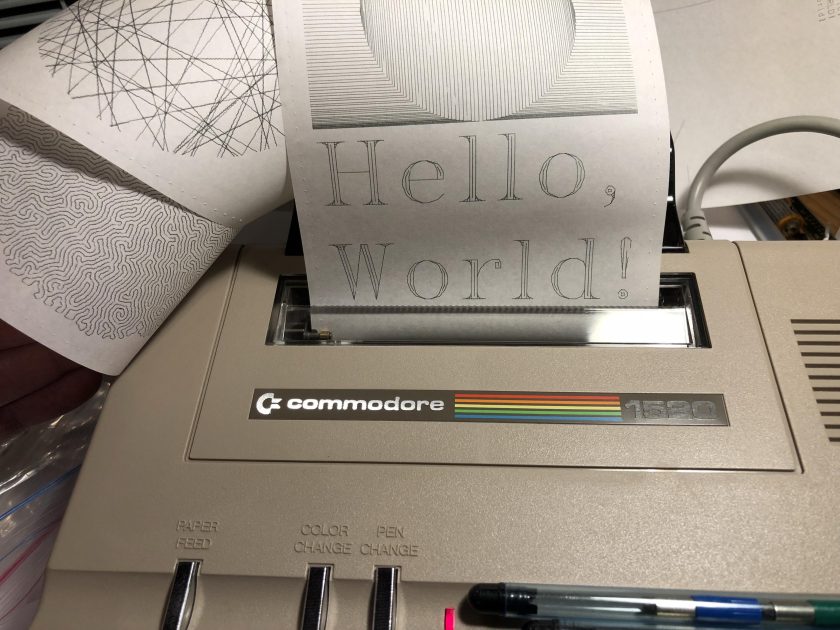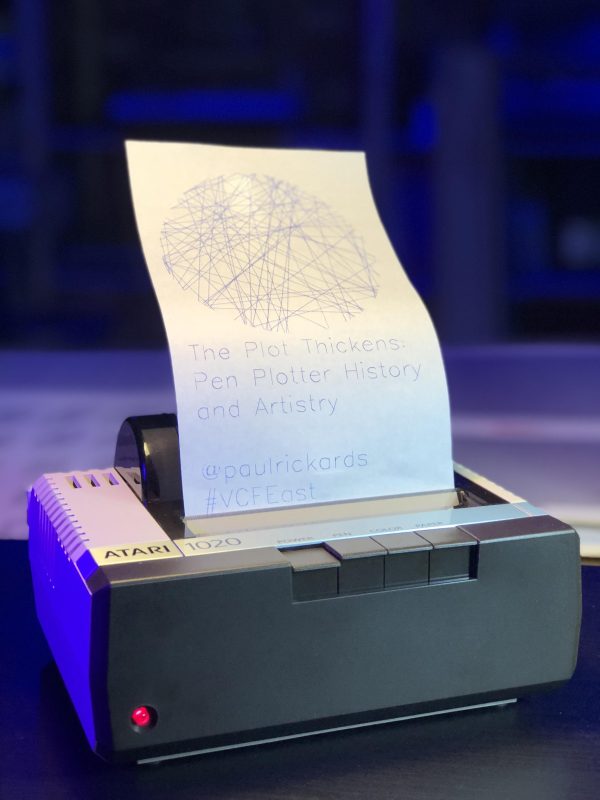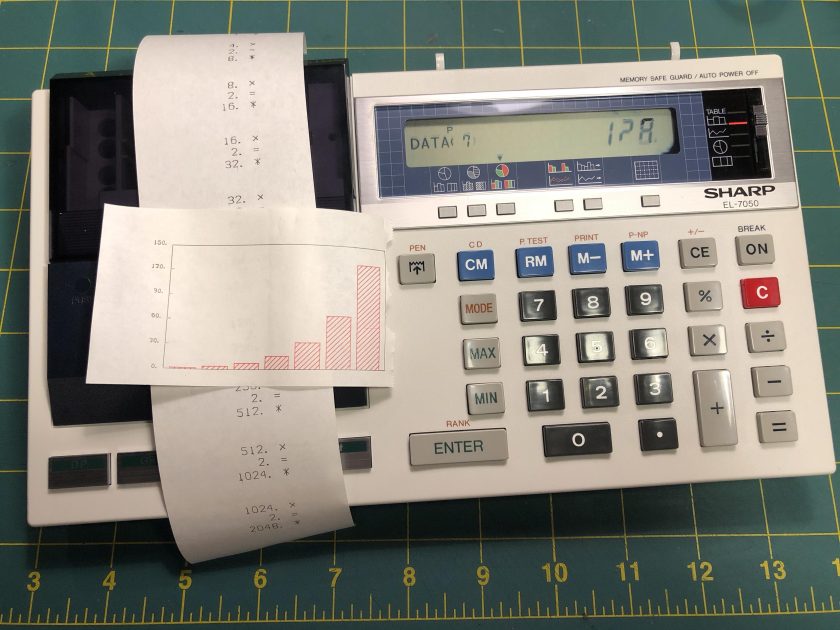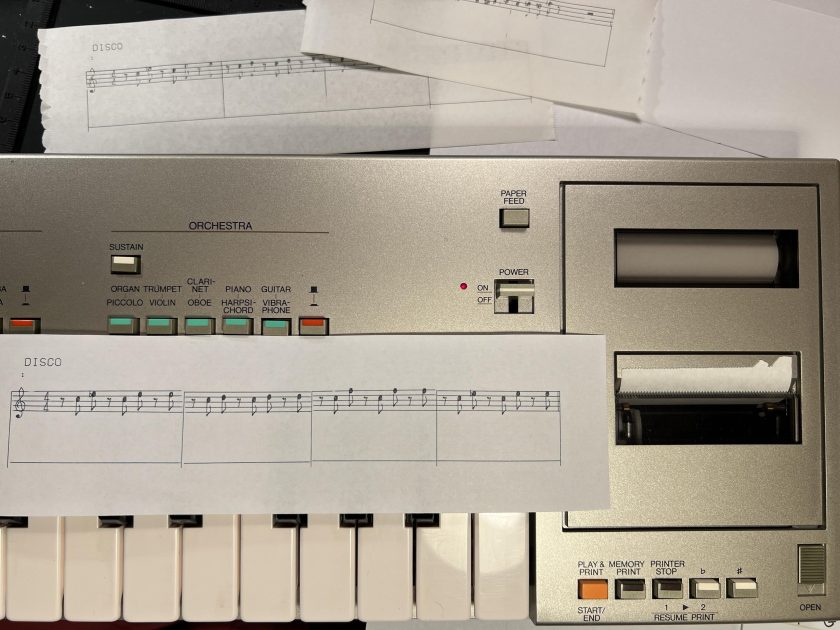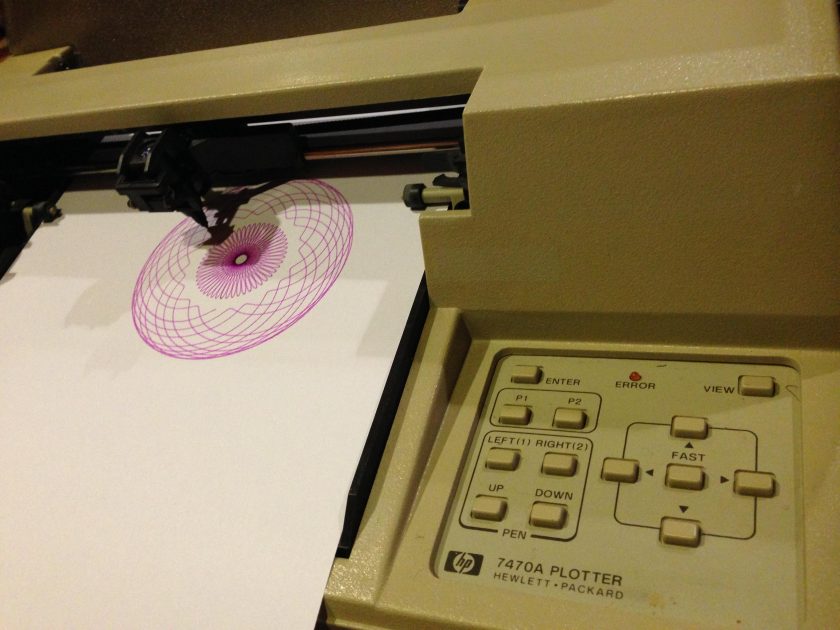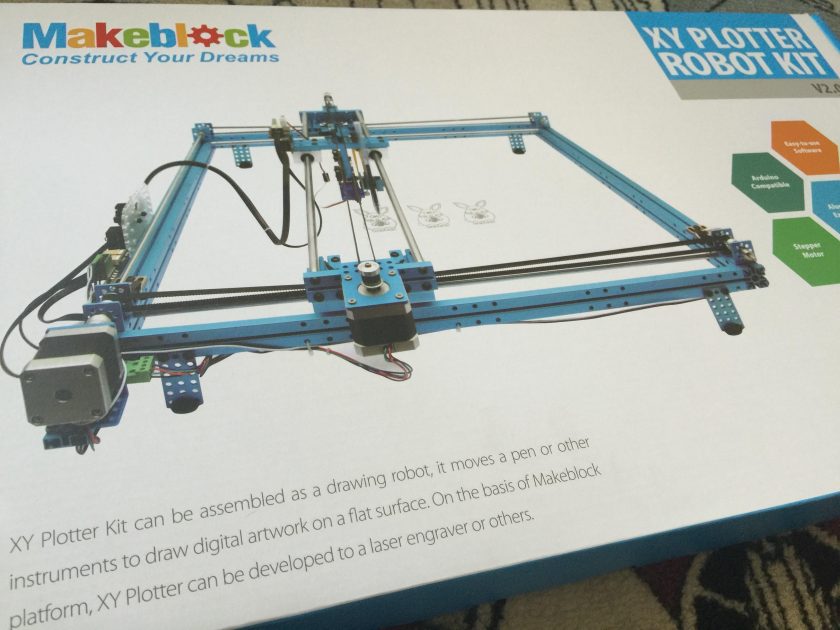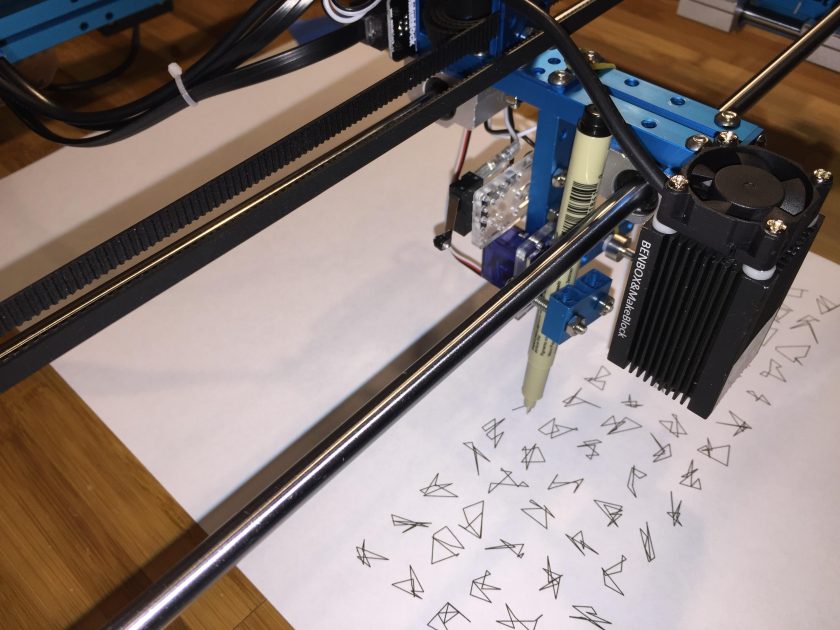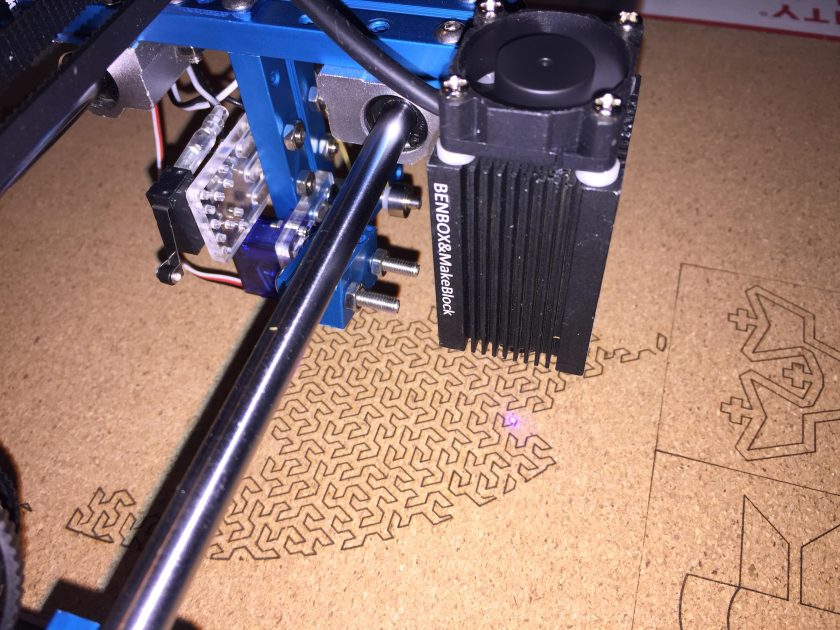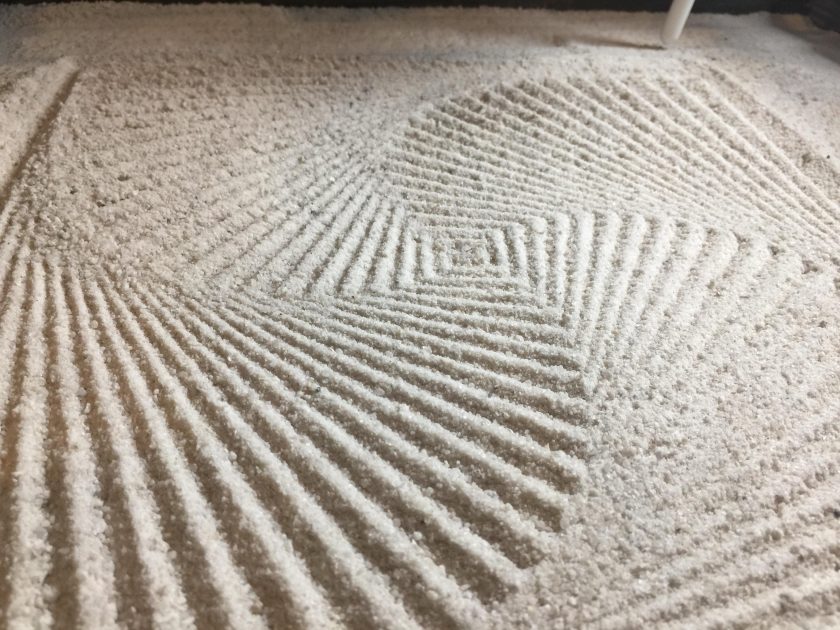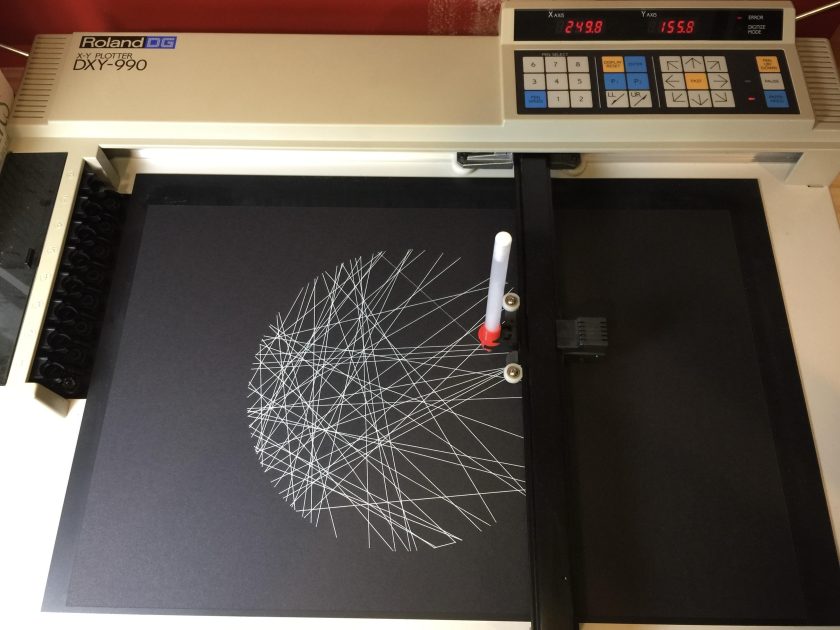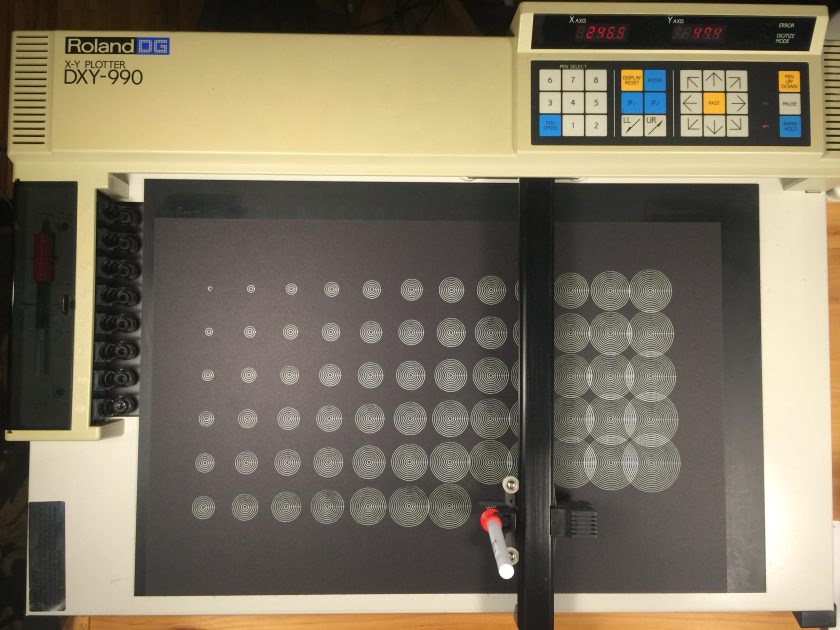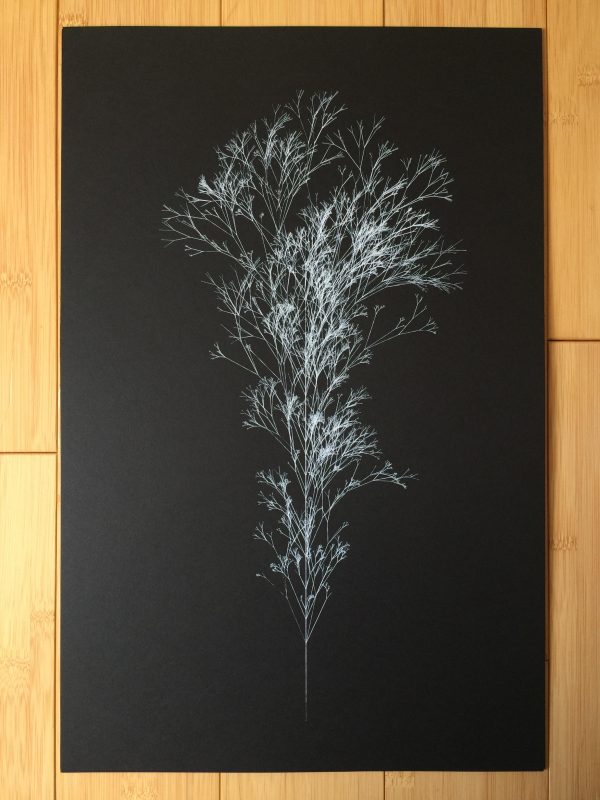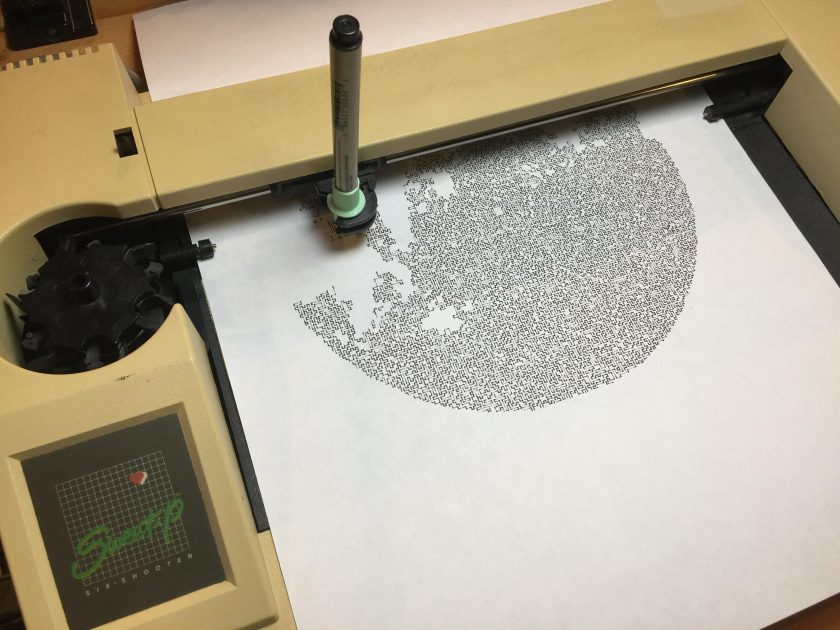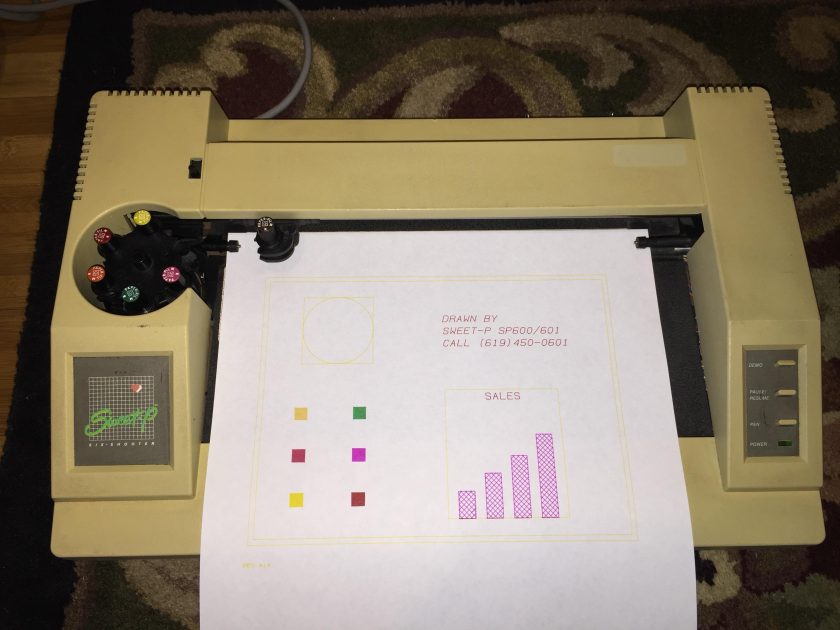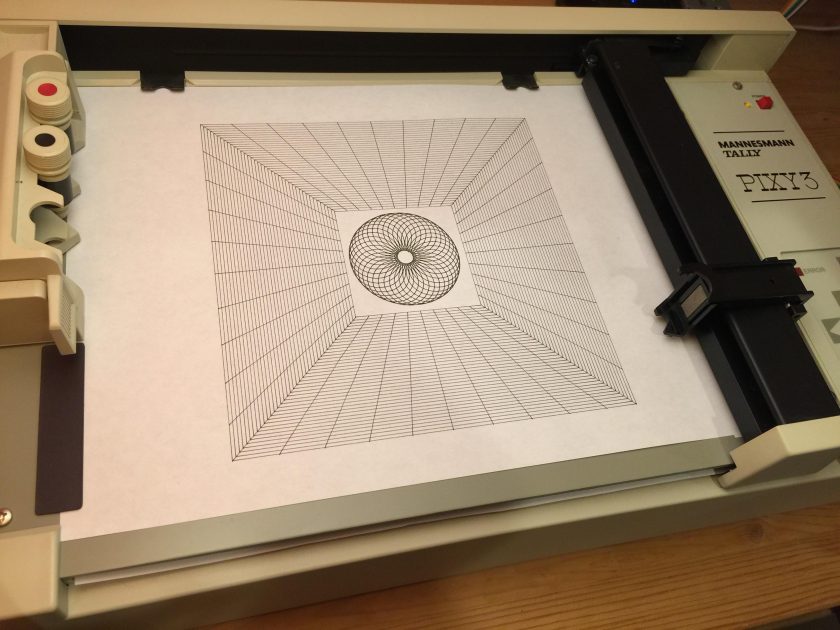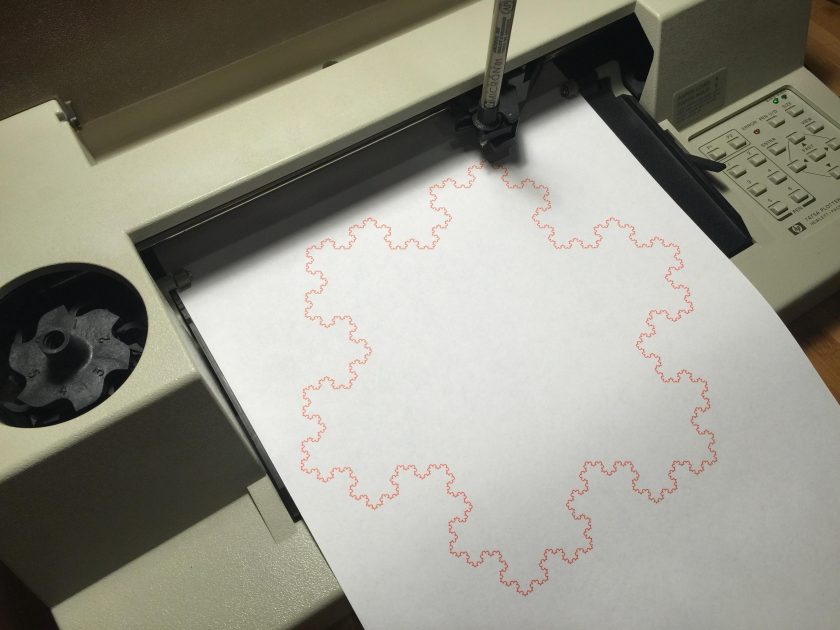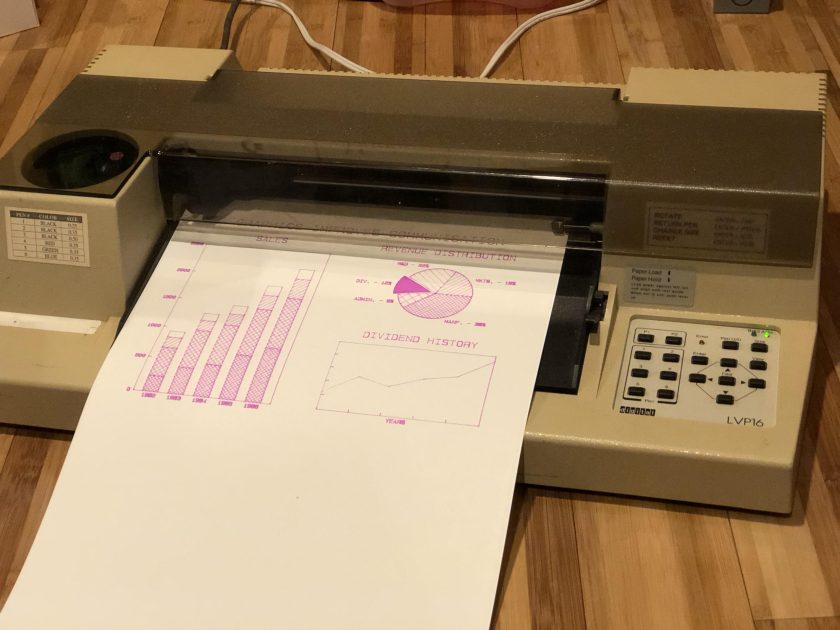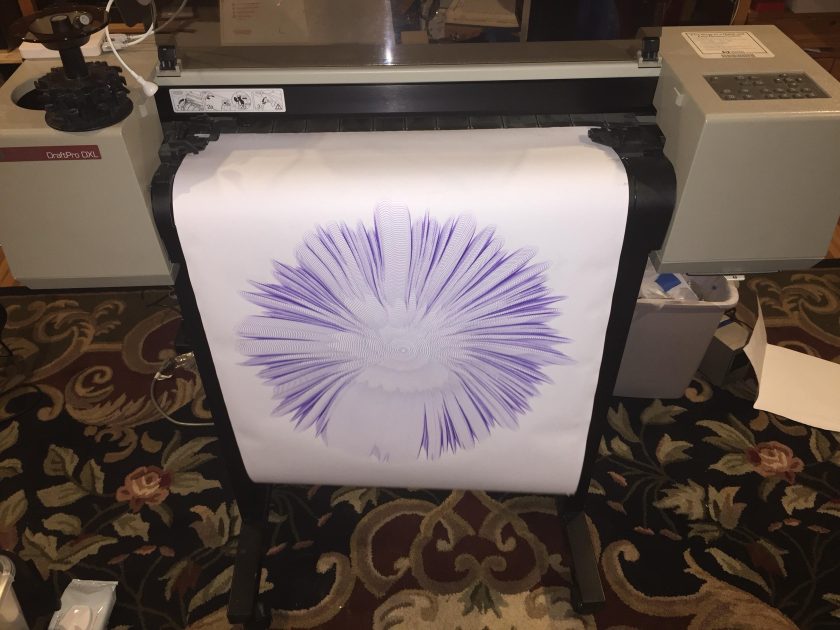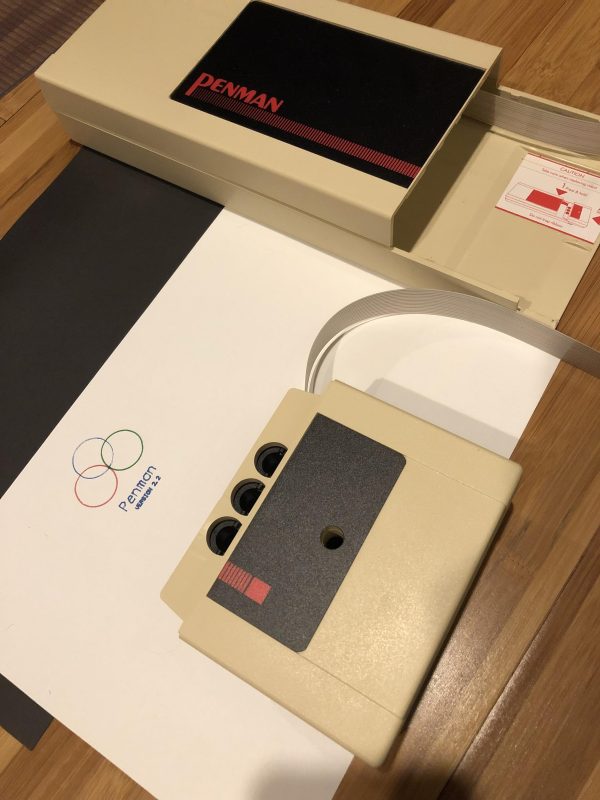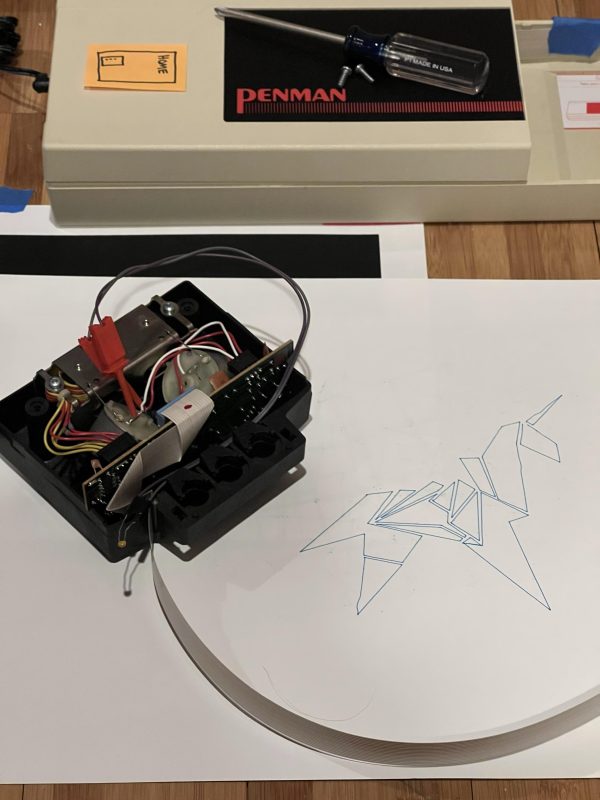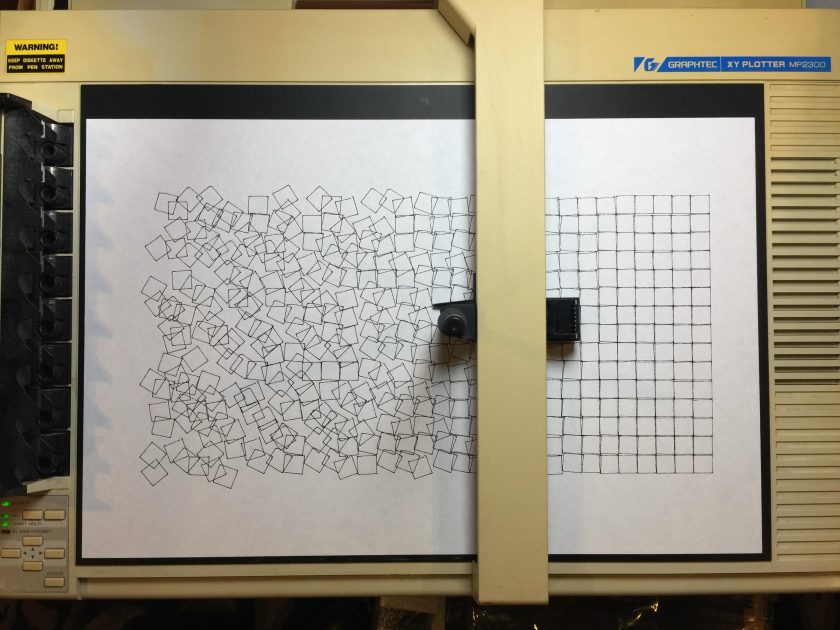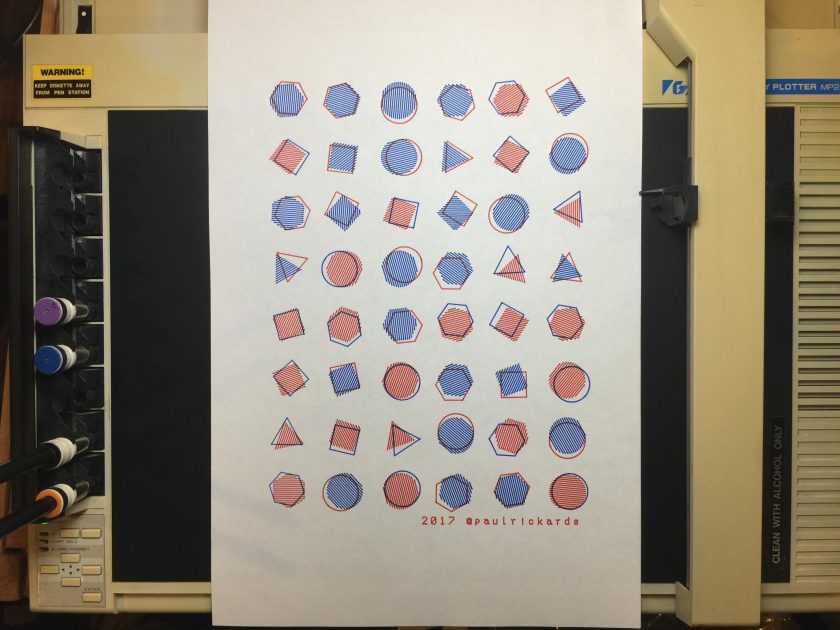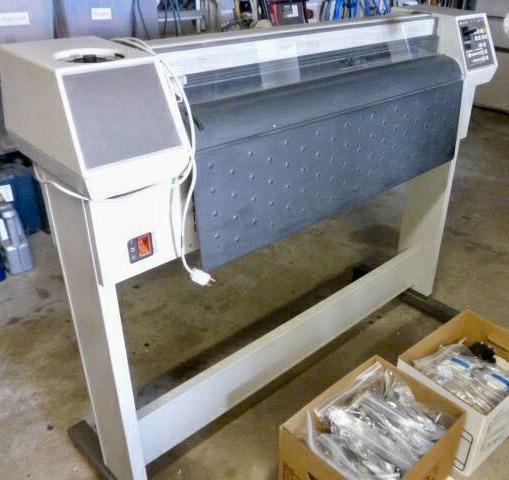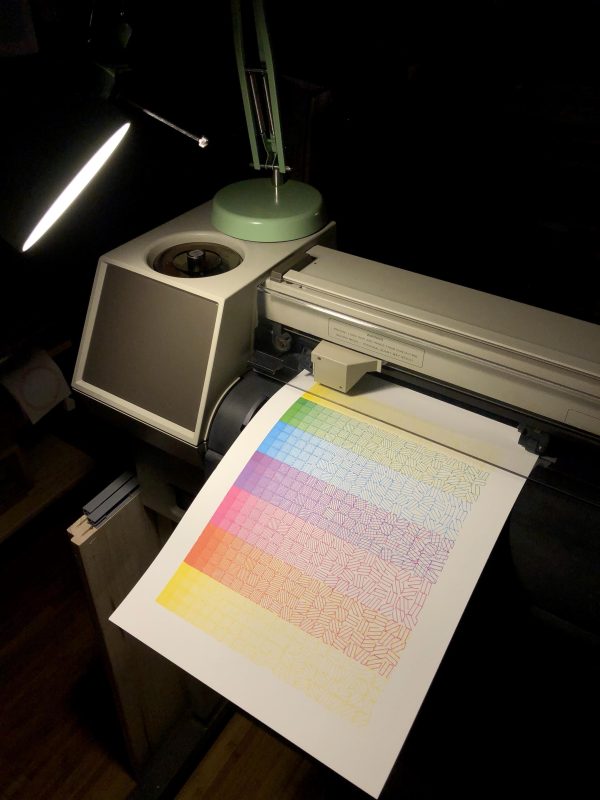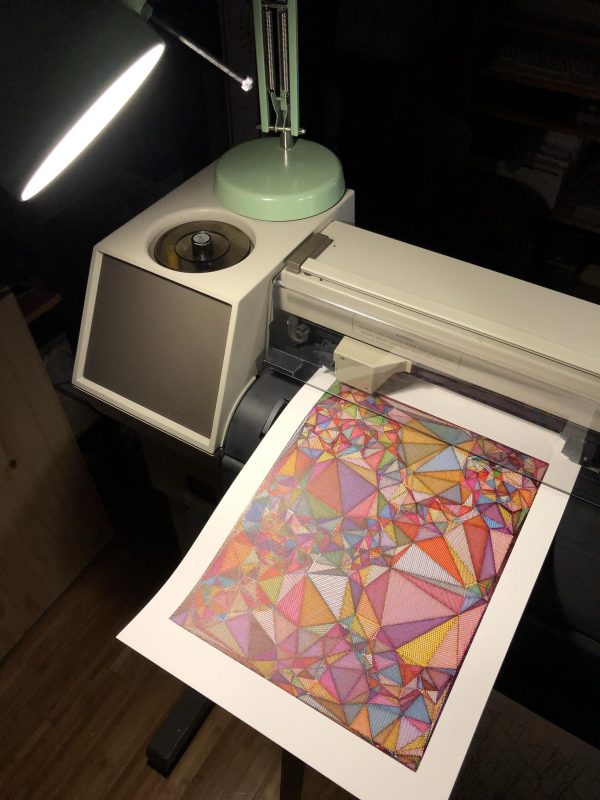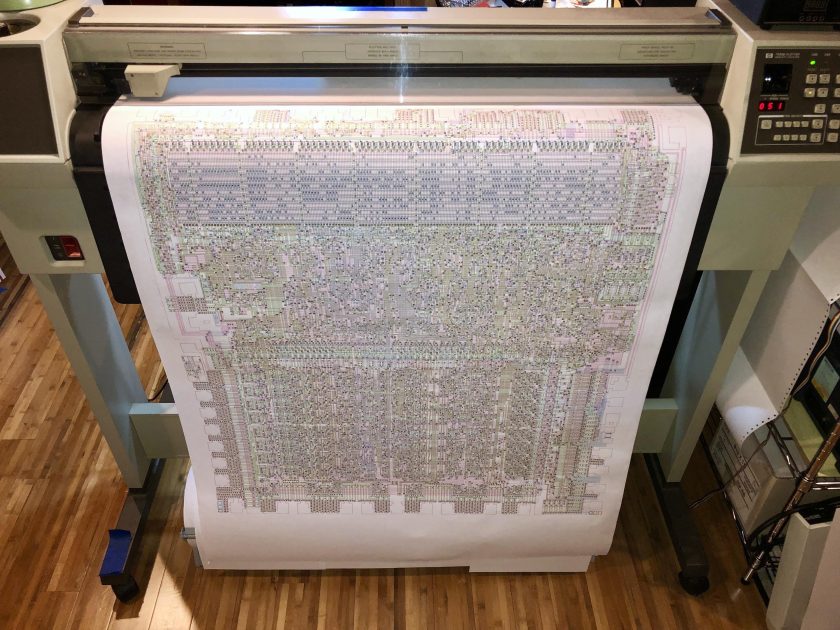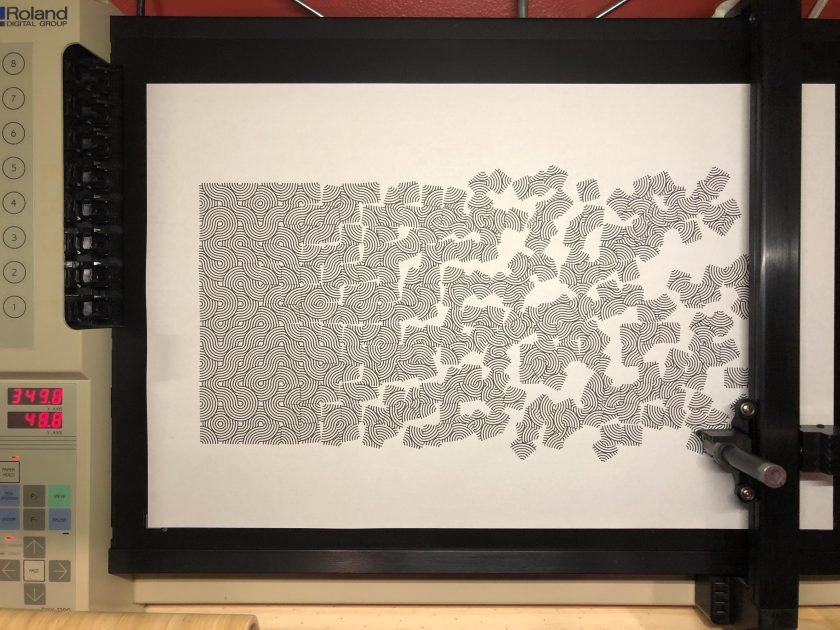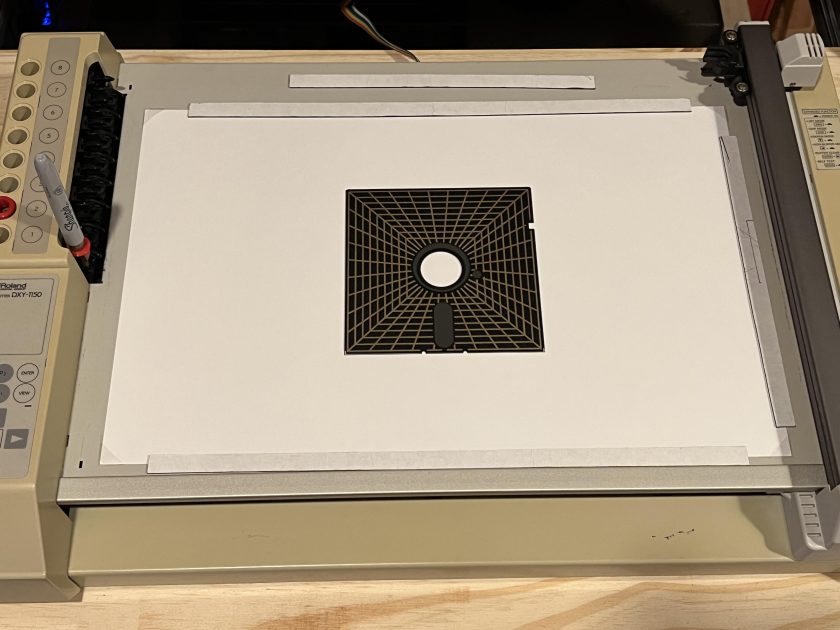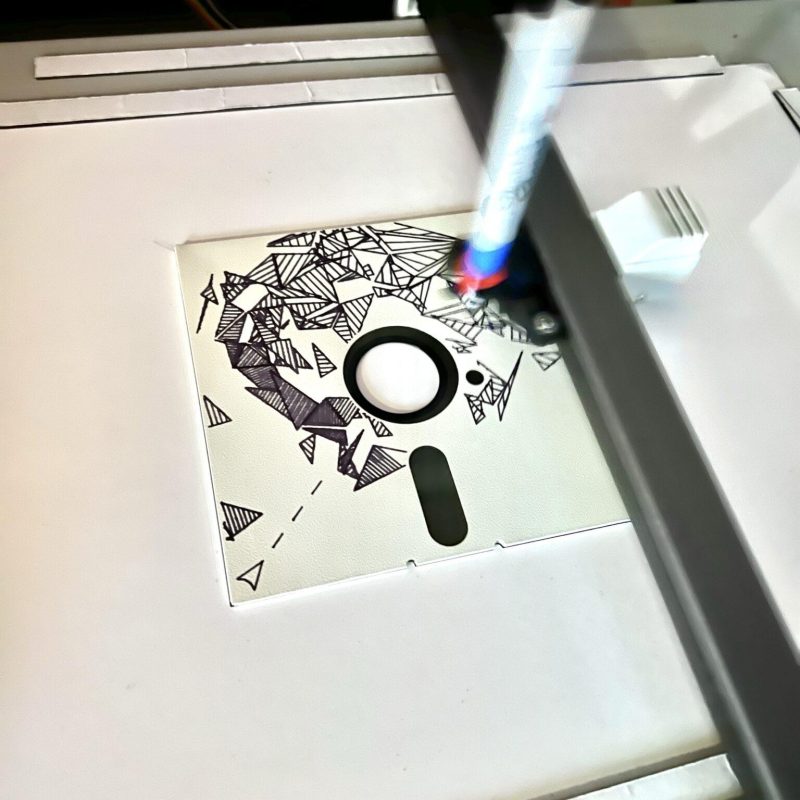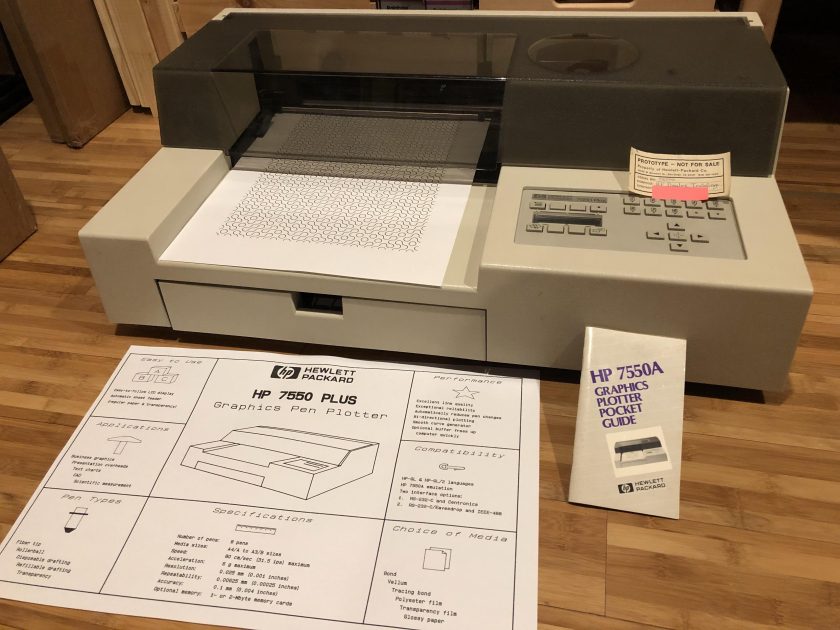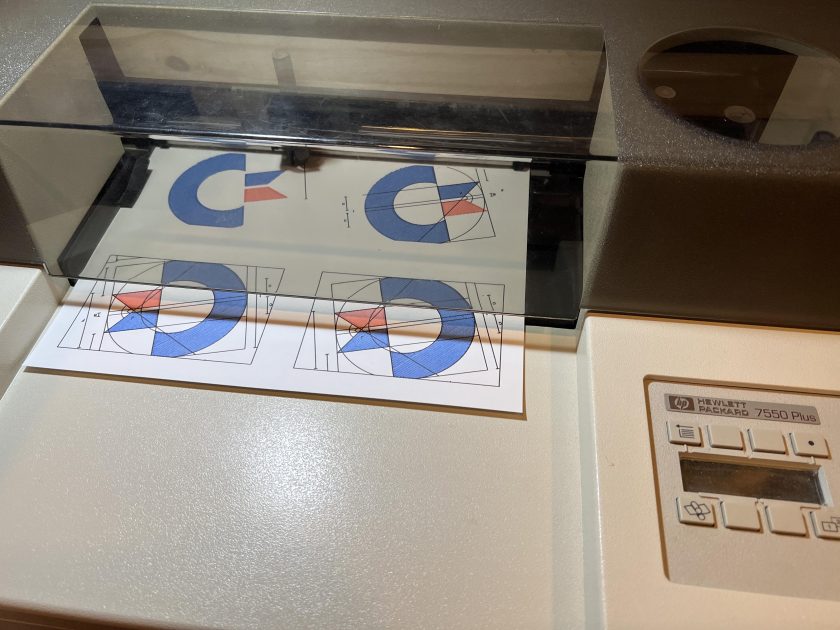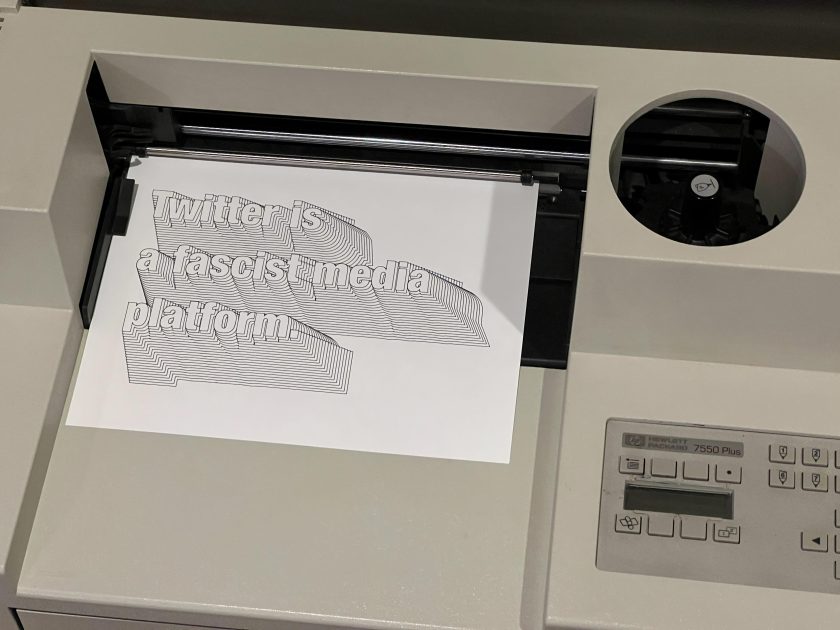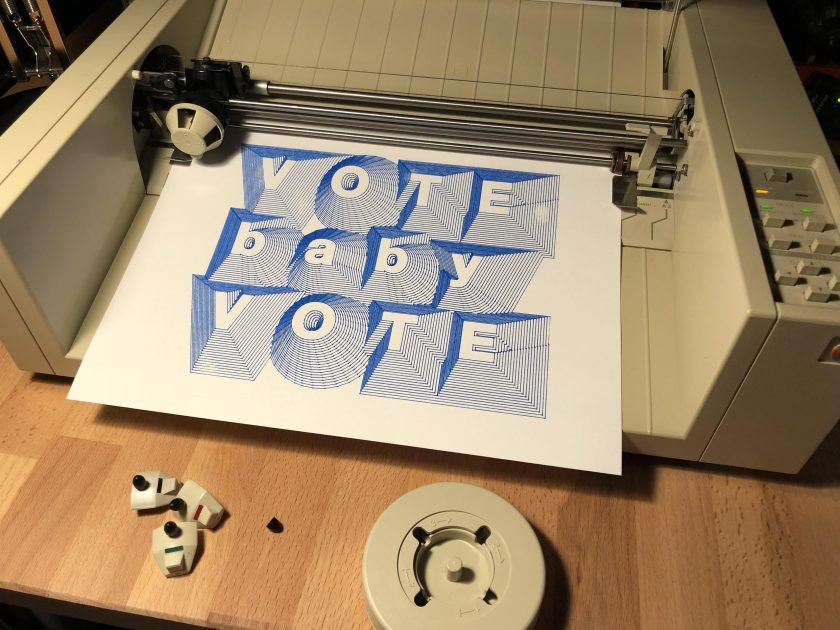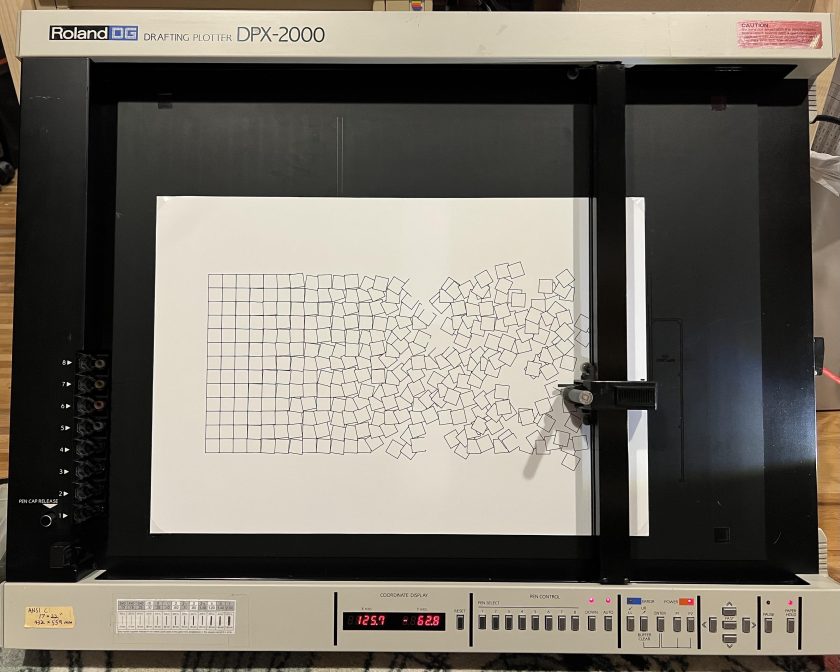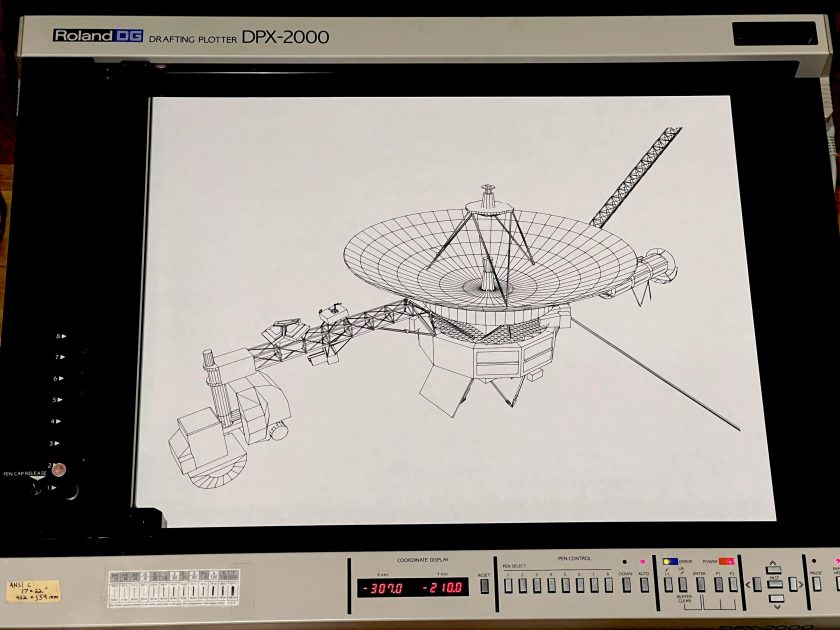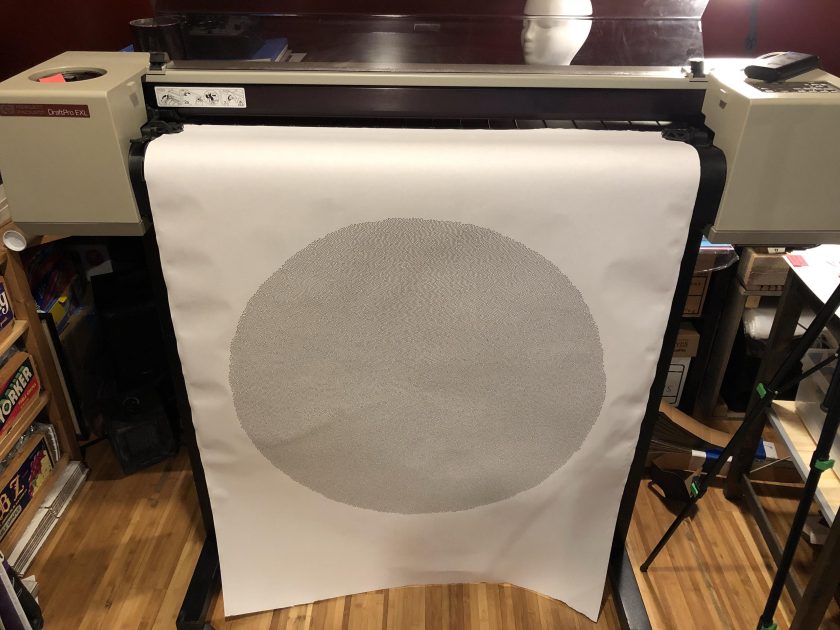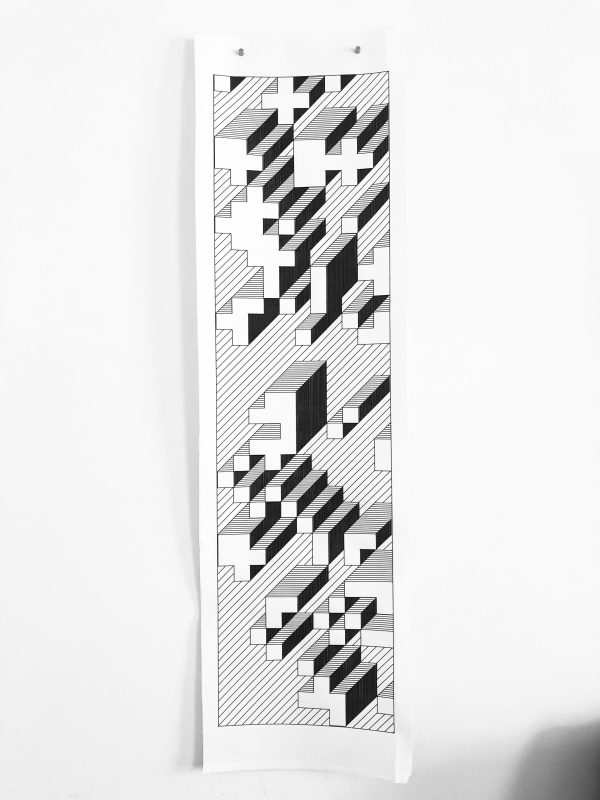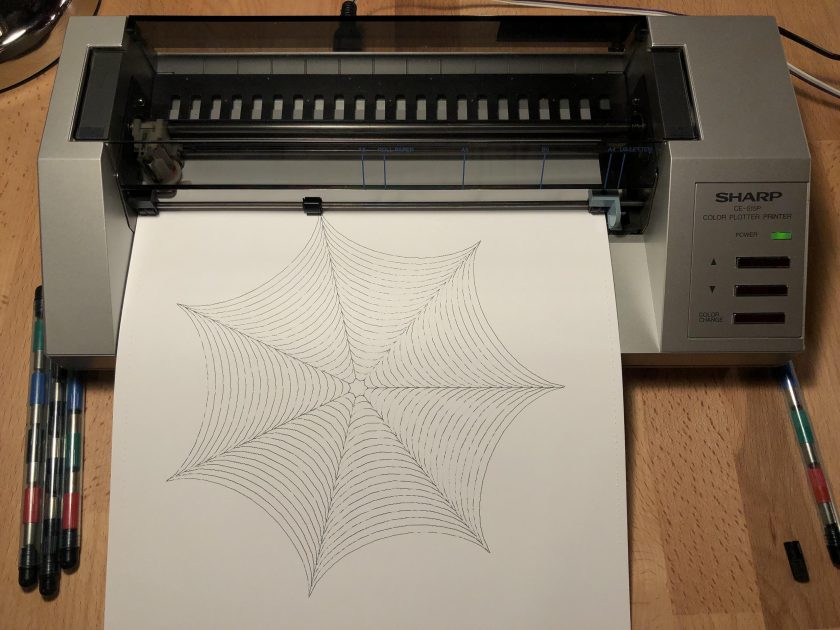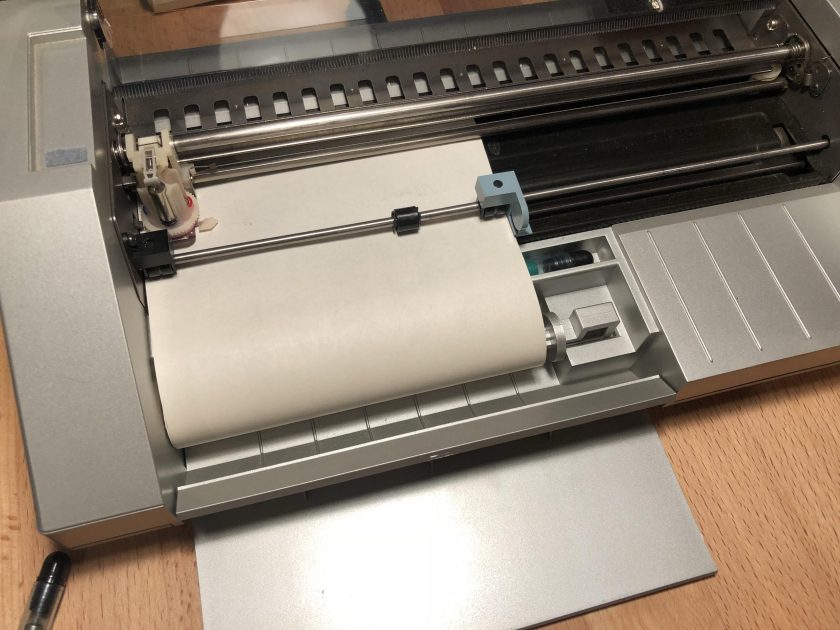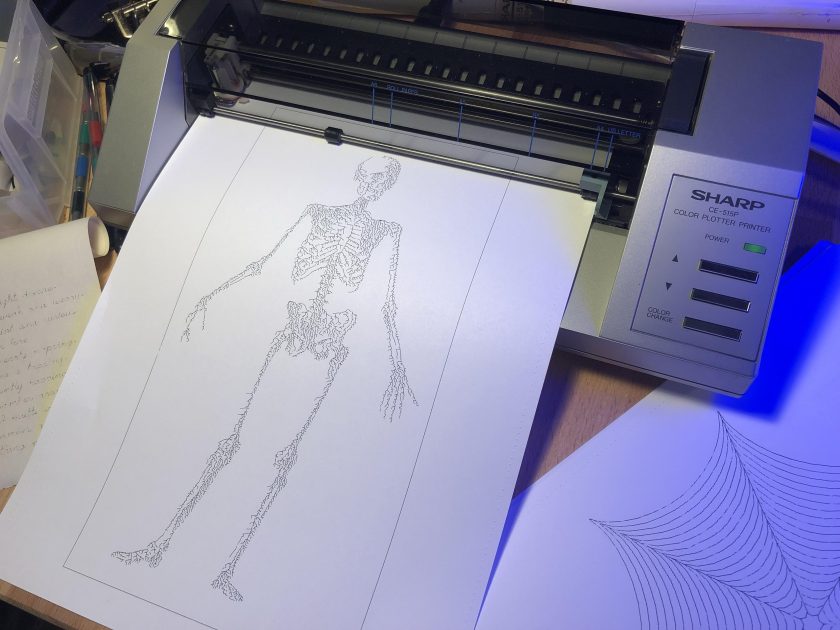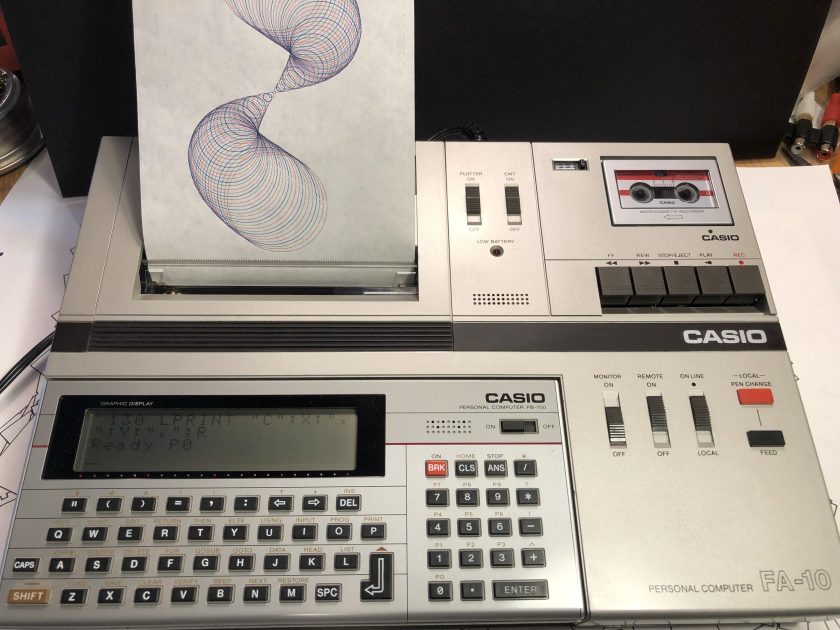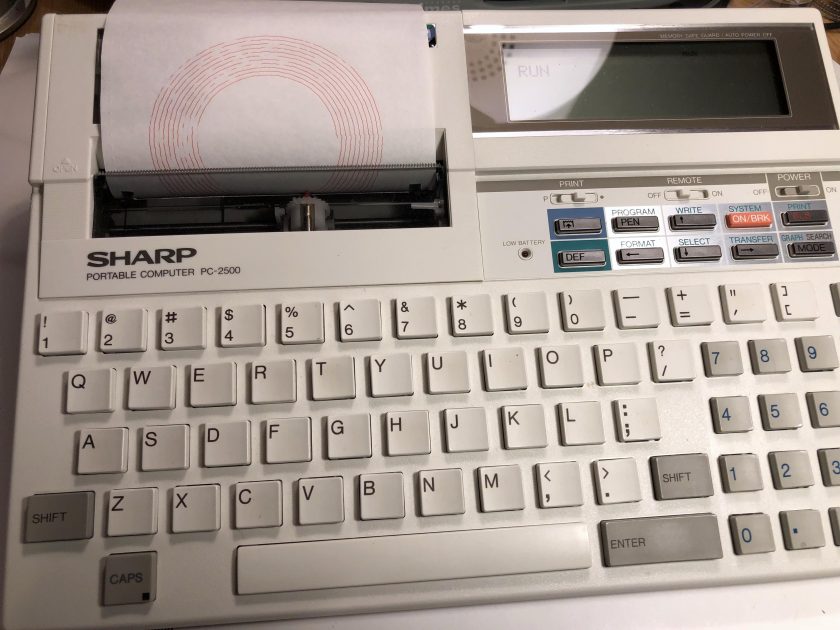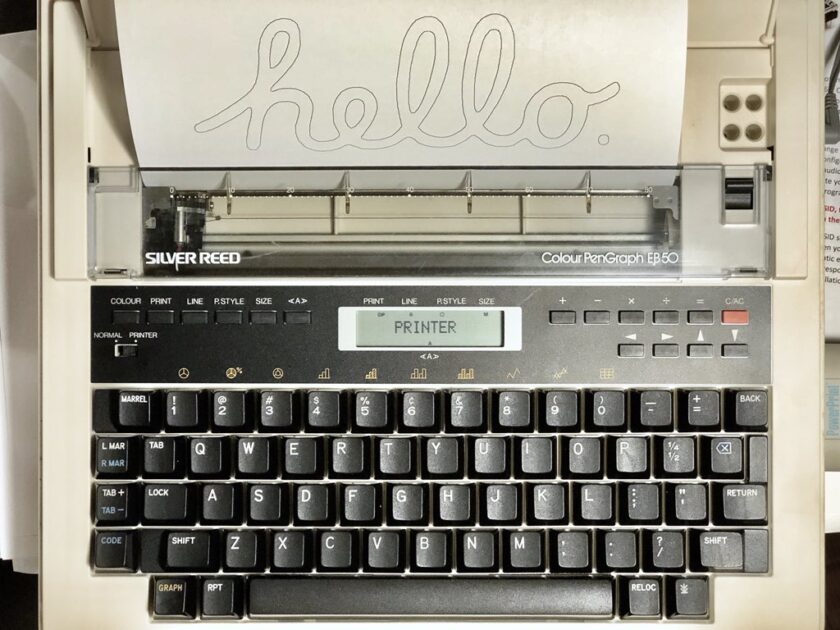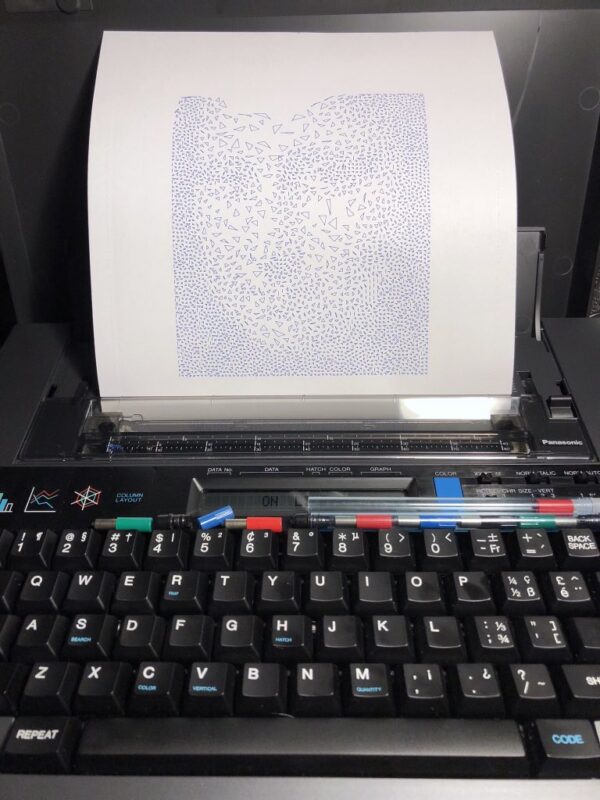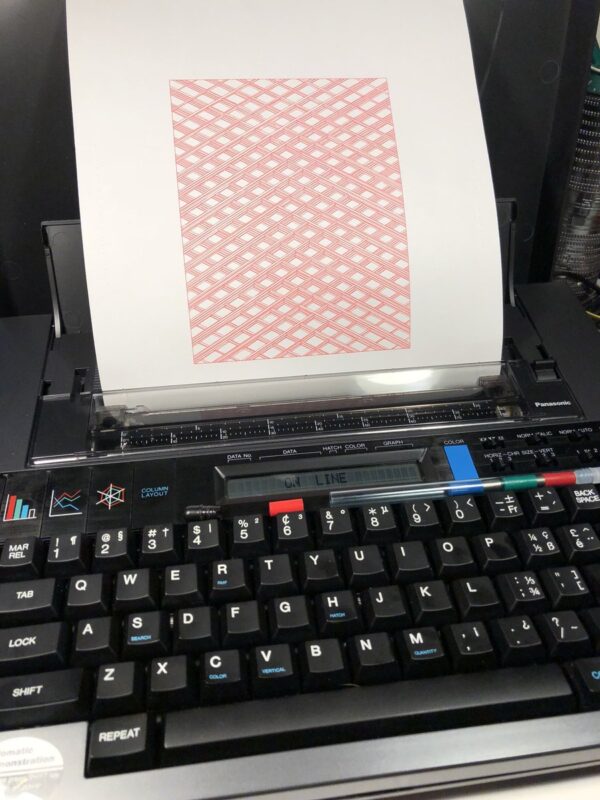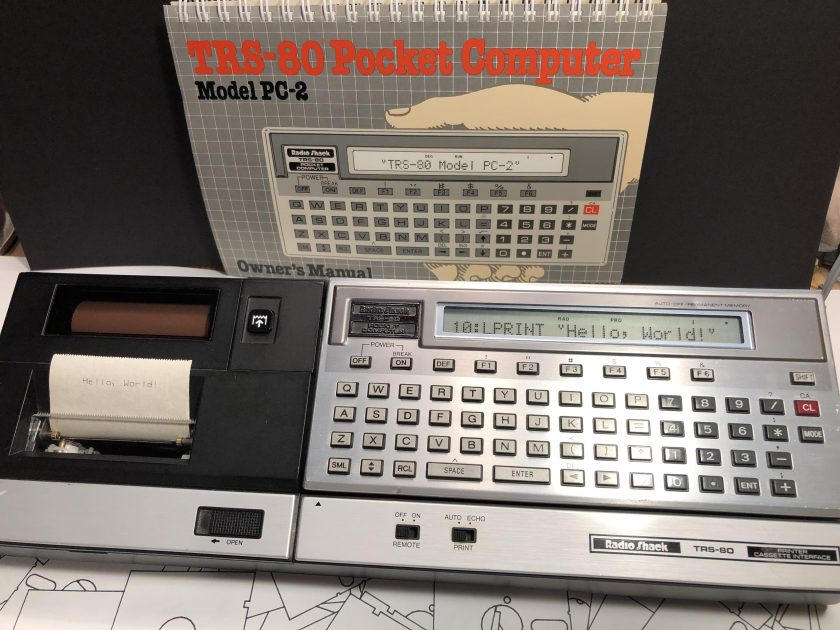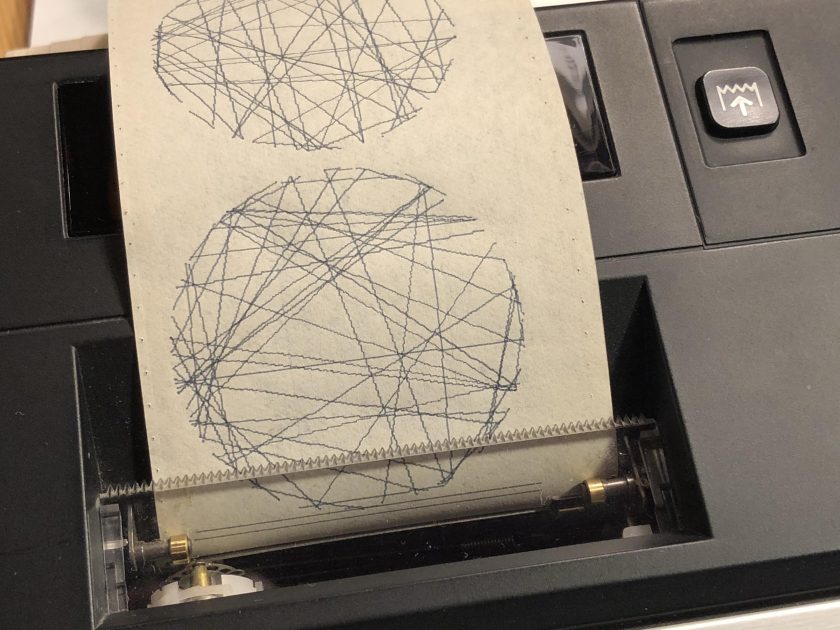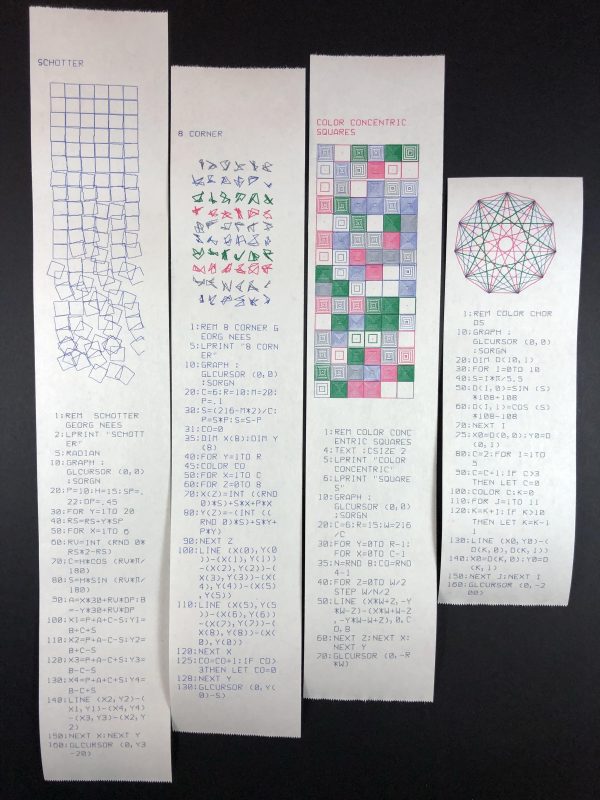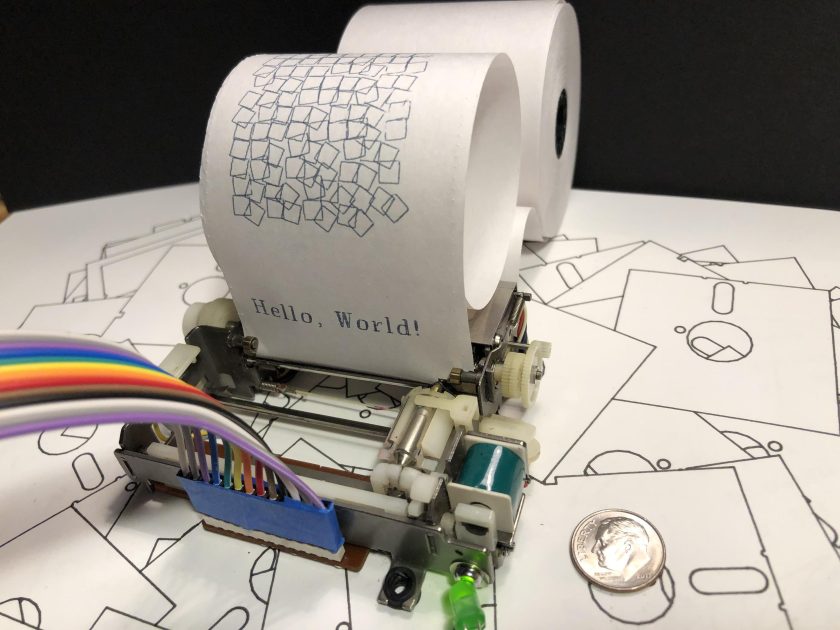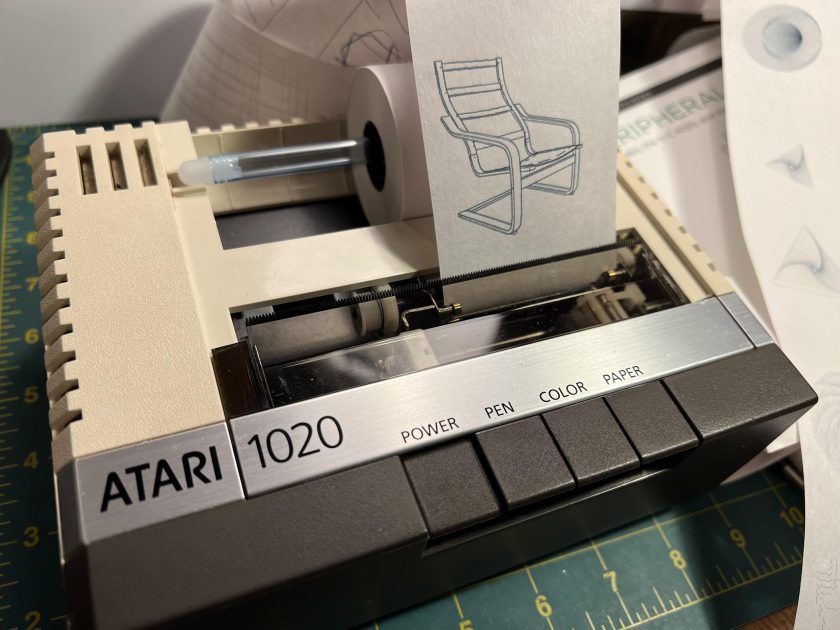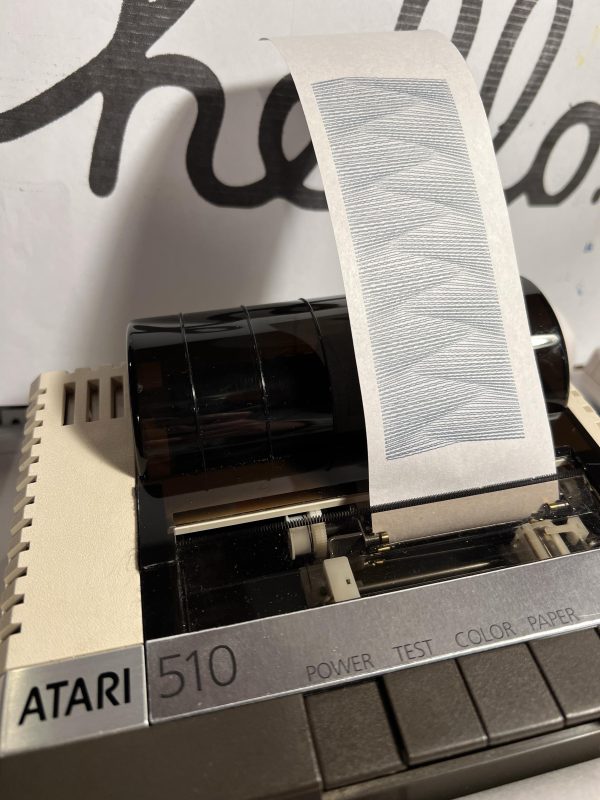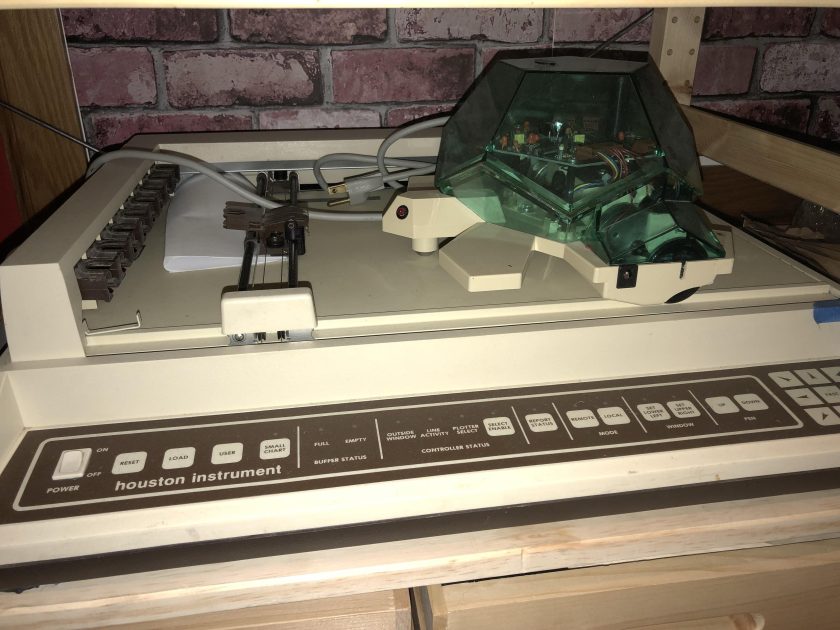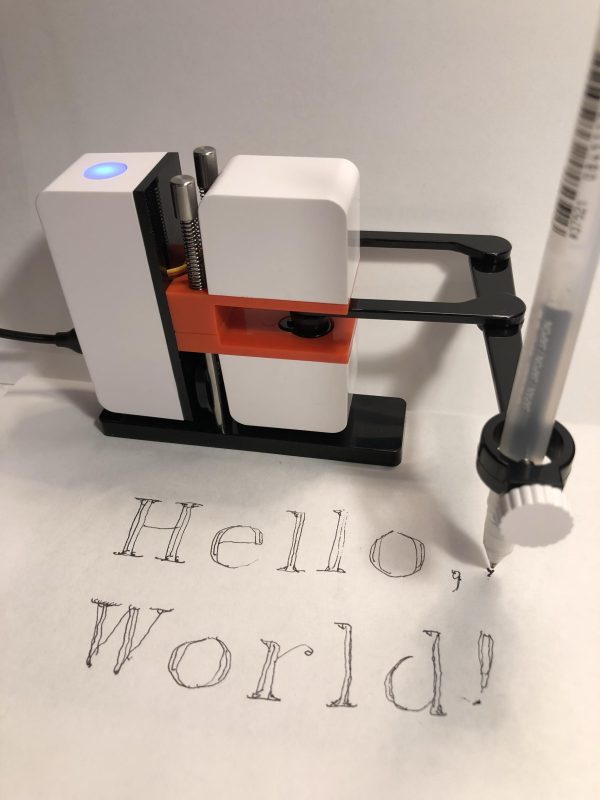Amazing to think I’ve been playing with pen plotters for over 10 years (longer if you count my first plotter, the Commodore 1520 with my VIC-20). What started out as a curiosity has continued to keep me engaged as a retro computing enthusiast and captivated as an artist. I thought I’d go back in time with some of the plotters I’ve used in various ways.
This was originally a post on Mastodon from July 30, 2024.
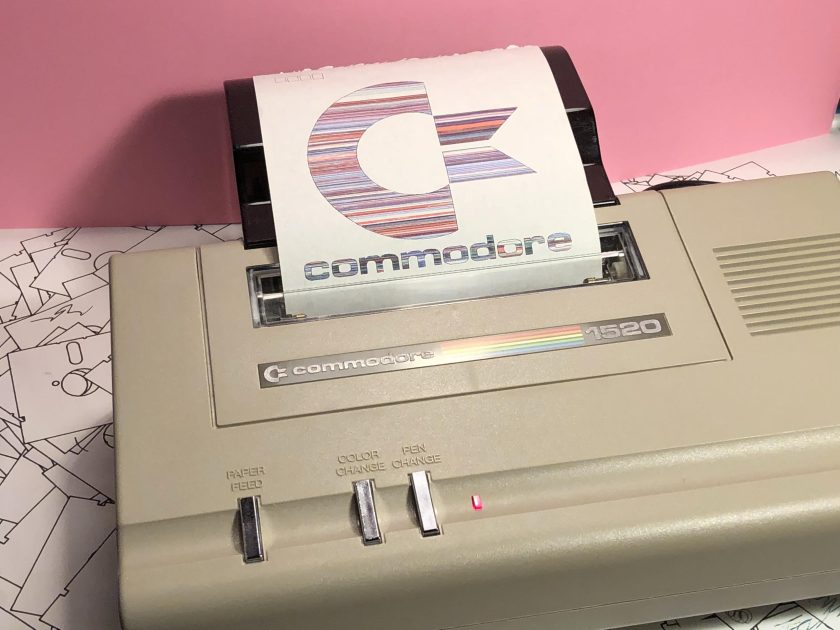
My first pen plotter was the Commodore 1520 when I was a kid. There were other variants based on Alps plotter mechanisms like the Atari 1020, Radio Shack Tandy CGP-115, etc. They were a great introduction to pen plotters and I’m still amazed to find the Alps mechanism stuffed into the oddest of retro tech like calculators and keyboards.
The gears on these suffer over time and split but I designed 3D printed replacements that have been working well for me.
My first “pro” plotter was a HP 7470A back in 2014. I was blown away that these existed, being that my only exposure up to that point was the tiny “toy” plotters.
This plotter was so fast but suffered from having only 2 pen stalls and a pen head that could only use the short HP style of pens so it was limiting. Still, I got hooked immediately.
In 2016, I discovered a plotter kit by MakeBlock. This was a fun build and had lots of room for creativity by modifying it. I drew with a pen, burned with a laser, and drew in sand. The firmware wasn’t great and needed modifications to do constant velocity, which is necessary when using a laser.
I made a very relaxing video of plotting in a sandbox.
Enter the Roland DXY-990 plotter. This was the top of the line model at the time, sporting 8 pen stalls and electro static paper hold. I liked this one so much I got three more Roland models.
I also started playing with white ink on black paper.
One of the loudest plotters I have is the Sweet-P Six-Shooter by Enter Computer. They basically took a HP 7475A tabloid, cloned it, shrunk it down, and sold it cheaper.
I brought this plotter to VCFEast, I couldn’t run it because it was so loud!
Speaking of quirky, here’s the Mannesmann Tally Pixy-3 letter sized plotter. It used a magnetic pen stall that held the pens in place as well as magnetic strips to hold the paper down. Keep your floppies away! Its small, slow, and pens are unobtainium but has a cute name.
Can’t forget about the HP 7475A, the best selling HP pen plotter. It set the standard that many other manufacturers followed including the grit wheel transport and the HPGL language. Just about every software package of the time supported this plotter. Later HP plotters emulated this machine, including inkjet plotters! I also have a rebranded DEC LVP16.
Now we’re getting serious. The HP DraftPro DXL was my first large format plotter purchased in 2017 and is still in use in my workshop today.
Introduced in 1988 at about $5,000, it was much cheaper than HP’s previous large format machines.
This machine does my 24”x36” CMYK works now which usually run between 6 and 10 hours.
Penman! It’s a plotter! It’s a turtle! It’s a mouse! Originating in England from 1985, it does it all with a unique detachable turtle design. It also does some clever maths to prevent itself from getting tangled in the ribbon cable while plotting.
I have several of these and unfortunately they all suffer a failure mode that I haven’t been able to resolve.
Here’s a video of Penman plotting the demo plot. It’s quite unique in the way it moves.
In early 2017, I picked up this Graphtec MP2300. It’s very similar to the Roland in features: 8 pens, tabloid size, electrostatic paper hold, and HPGL language. It’s a decent plotter. However, it doesn’t use HP style pens. It uses Graphtec style with metal rings for magnetic pen stalls, like the Pixy (and likely the same too— I need to check).
Another day, another giant plotter. This HP 7585B is a 36” wide plotter, made from cast metal parts and is impressively sturdy and heavy. I couldn’t fit it in my vehicle but the local seller was motivated to get rid of it so loaded into their minivan.
Boxes of pens usually come in tow when I get a plotter which are a mixed bag.
The HP 7585B smoked upon first power up and proved to be a tricky repair (for me). I wrote about that experience.
Once it was repaired, the HP 7585B became MVP (most valuable plotter) It’s super fast, can plot up to 36”x48” (A0), and can run all day without issue.
Introduced in 1982, it cost $21,900!! Adjusted today would cost $67,521!!
There’s a lot of clever engineering in this machine like Teflon coated paper paths to reduce friction.
I liked the Roland plotter so much I got another. This is an updated version, the DXY-1200, same electrostatic paper hold, coordinate display, but a bit faster.
And another: the Roland DXY-1150. It lacks electro static paper hold and coordinate display but pretty much the same as the 1200. This one began life as a cable label printer. Today it’s my specialty plotter for floppy disks and the like.
And here’s peak HP desktop plotters: the HP 7550+ which features an automatic paper feed tray (letter or tabloid if you have the tray), 8 pen carousel, and the fastest HP desktop plotter made. I use this plotter all the time for draft ideas as well as postcards. It’s also a crowd favorite at shows.
Even Apple got in on the plotter gig with the Apple 410 Color Plotter. It’s styled just like an original ImageWriter. It’s actually an OEM’d Yokogawa YEW PL-1000. The pens are really weird and aren’t used anywhere else that I’m aware of. It’s also really slow.
Wait, there’s one more Roland and it’s a big one.
The Roland DPX-2000 is an ANSI C sized plotter. They basically scaled up their DXY A3 series plotters and kept all of the features: 8 pens, coordinate display, and electrostatic paper hold. Everyone loved it at VCF East. It’s a little on the slow side but I think that makes it more captivating to watch.
One more HP: the big brother to the DXL, the HP DraftPro EXL. Basically the same except 36” wide paper path. This one I got on eBay and much to my surprise wasn’t damaged in shipping at all.
You adjust the paper width manually by sliding the right side grip wheel, anywhere from 8.5” to 36” so it’s very flexible on paper sizes.
In 2020 I got a Sharp CE-515P plotter. It’s small in comparison to most, and uses either roll paper (4” or 8.5” wide) or letter sheets. It has a trap door where it stores 4” wide roll paper! I think it was meant to pair with a Sharp slabtop.
It uses an Alps mech so it needs those same tiny ball point pens that the Commodore 1520/Atari 1020/etc. uses.
Speaking of slabtops, this Casio FA-10 docking station has a cassette and 4” wide Alps pen plotter built in.
This was the first plotter I did an animation with in BASIC!
Another all in one slabtop, the Sharp PC-2500 uses the same Alps 4” wide plotter. The keyboard on this one is much better than the other pocket computers. It uses BASIC as well.
I’ve also collected several kinds of typewriter plotters— they draw text and graphics with ball point pens! See this separate post about typewriter plotters.
Oh I almost forgot the TRS-80 PC-2 pocket computer and cassette dock with Alps 2” wide plotter. I had fun with this system making some generative designs in BASIC.
I cobbled together this plotter from a surplus Alps DPG-1301 2” mech and an empty Atari 1020 case to make the “Atari 510” because it’s 1/2 the width. It’s driven with Grb_ESP32 Atari board by @buildlog.
A visit to the plotter hospital shows our weary patients the A3 Houston Instruments DMP-29 and the Valiant Turtle.
The DMP-29 shipped with minimal packing and was severely cracked and I could never figure out why the motor drive didn’t work.
The Valiant awaits some free time. Recently @LinuxJedi restored theirs.
The newest plotter I have is from 2019, the Line-Us. It has a rather small plot area and a really nervous line quality. It also has some weird pen height issues I’ve never fully worked out. Someone added googly eyes to theirs and it felt appropriate so I did too because it really tries.
Given the line quality, it works well with the Quick, Draw! dataset.
